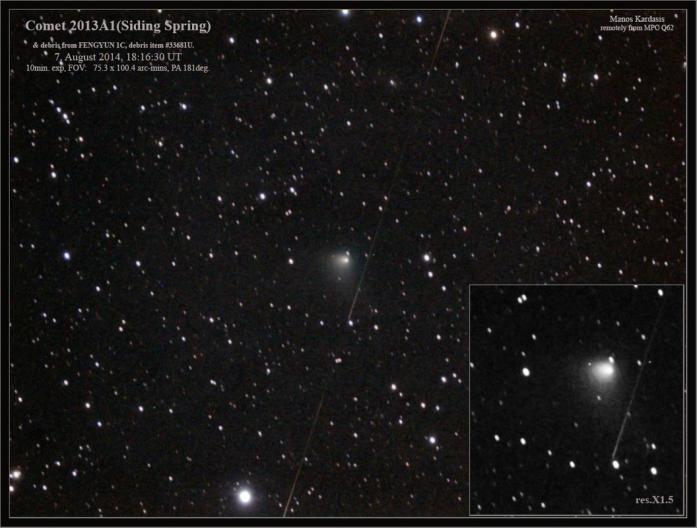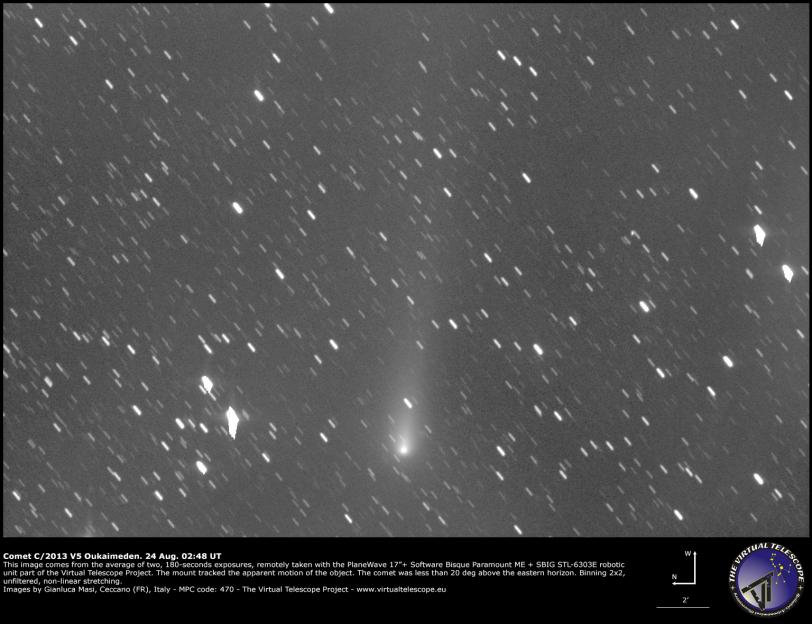COMET SECTION NEWS FOR SEPTEMBER 2014
2014-September-28
Section Updates
As September begins Comet C/2014 E2 (Jacques) should be a bright 7th magnitude in the evening sky. Jacques will fade rapidly as it moves away from the Sun and Earth. The morning sky is the home of two additional bright comets. C/2012 K1 (LINEAR) will once again become visible around ~7th magnitude and C/2013 V5 (Oukaimeden) may brighten from ~8th to 5th magnitude. Oukaimeden is an intrinsically faint comet making its first passage through the inner Solar System. Such comets have a history of rapid fading or even disintegration. Close monitoring is requested.
August was a very active month for the Comet Section. A number of observations were submitted for bright comets C/2014 E2 (Jacques) and C/2013 V5 (Oukaimeden) as well as fainter comets such as C/2011 J2 (LINEAR), C/2013 A1 (Siding Spring), C/2013 UQ4 (Catalina), C/2014 M3 (Catalina), C/2014 Q3 (Borisov), 108P/Ciffreo and 110P/Hartley 3. Visual magnitude observations were submitted by Carl Hergenrother (12), Willian Souza (8), John Sabia (2) and Salvador Aguirre (1). CCD images and drawing were submitted by Denis Bucyznski, Jean-Francois Coliac, Carl Hergenrother, Manos Kardasis, Gianluca Masi, Frank Melillo, and John Sabia. Thanks to everyone who contributed observations in August.
Thanks to the efforts of Gary Kronk, much of the Comet Section archive (post-1980) has been digitized. The images and drawings have been uploaded to the Section Gallery. I would also like to mention John Sabia for sending in many of his older comet images and Gary Nowak for contributing his recent magnitude estimates. Currently the Image Gallery includes ~800 images of 125 different comets going back to 1965’s Ikeya-Seki. Unfortunately, much of the material submitted to the section prior to 1980 is MIA. If you have observations of any comets, and specifically those before 1980, that are not in the Comet Image Gallery, please consider submitting them (perhaps again) to the Section.
Evening Comets
C/2014 E2 (Jacques) [Perihelion on 2014-Jul-02 at 0.67 AU from the Sun]
Comet Jacques is the brightest comet of 2014 having peaked at V ~ 6 in early/mid-July (not counting small SOHO comets very close to the Sun). Now almost 2 months past perihelion, Jacques has been intrinsically fading at a fast rate during August. Though moving away from the Sun, the comet rapidly approached Earth and passes within 0.56 AU of us on Aug 28/29. The decreasing range to the comet helped offset the comet’s intrinsic fading and as a result it is still around V ~ 7 at the end of August.
On September 1, Jacques is located 1.35 AU from the Sun and 0.58 AU from Earth. By the end of the month it will be 1.79 AU from the Sun and 1.30 AU from Earth. The comet is well placed in the evening sky for northern observers and will be visible to most southern observers by mid-month. The comet starts September is Cepheus (Sept 1) and then moves through Cygnus (Sept 2-14), Vulpecula (14-21), Sagitta (21-24) and Aquila (24-31). The comet is expected to fade from magnitude 7 to 10.
Recent ALPO images and observations of C/2014 E2 (Jacques) can be found in the Comet Section Image Gallery and Magnitude Database. Finder charts can be found on the Comet Chasing website.

Frank's image of Comet Jacques does a great job of showing how the comet looks in small binoculars (fairly round, well condensed, ~10' coma).
C/2013 A1 (Siding Spring) [Perihelion on 2014-Oct-25 at 1.40 AU from the Sun]
Siding Spring will pass within ~132,000 km of Mars (just 1/3rd the Earth-Moon distance) on October 19. For Martians and spacecraft near Mars, the comet will be a brilliant object of negative magnitude. Here on Earth, the comet is a southern object for much of the month. It moves from Tucana (Sept 1) to Octans (Sept 1-4), Pavo (4-17), Telescopium (17-21), Ara (21-25) and Scorpius (25-31). The comet should be in the 9th-10th magnitude range all month.
Recent ALPO images and observations of C/2013 A1 (Siding Spring) can be found in the Comet Section Image Gallery and Magnitude Database. Finder charts can be found on the Comet Chasing website.
Morning Comets
C/2012 K1 (PANSTARRS) [Perihelion on 2014-Aug-27 at 1.05 AU from the Sun]
Comet PANSTARRS passes perihelion on August 27 though it will be located on the other side of the Sun. A difficult morning object at the start of the month, the comet gets progressively easier to observer over the coming weeks as it moves through Cancer (Sept 1) and Hydra (Sept 1-31). On Sept 1, it will be 1.06 AU from the Sun and 1.90 AU from Earth and perhaps as bright as 7th magnitude. By the end of the month it will be 1.20 AU from the Sun and 1.35 AU from Earth. The decreasing distance from Earth should produce a slow brightening of the comet.
Recent ALPO images and observations of C/2012 K1 (PANSTARRS) can be found in the Comet Section Image Gallery and Magnitude Database. Finder charts can be found on the Comet Chasing website.
C/2013 V5 (Oukaimeden) [Perihelion on 2014-Sep-28 at 0.63 AU from the Sun]
Comet Oukaimeden may the object to watch this month. Already magnitude 7.5-8.0 at the start of the month, it could brighten to 5th magnitude. The comet is dynamically new (making its first passage through the inner Solar System) and intrinsically faint. It is possible the comet may disintegrate similar to what we saw last year with ISON. In fact, the comet’s appearance on CCD images is reminiscent of ISON at the same heliocentric distance. All types of observations are requested.
Southern Hemisphere observers will be able to follow Oukaimeden through perihelion. Northern observers will loss the comet after the first week or two of September. The comet’s heliocentric distance decreases from 0.85 AU on the 1st to 0.63 AU at perihelion on the 28th. Its heliocentric distance drops from 0.85 AU to 0.48 AU at mid-month and back to 0.83 AU at the end of the month.
Recent ALPO images and observations of C/2013 V5 (Oukaimeden) can be found in the Comet Section Image Gallery and Magnitude Database. Finder charts can be found on the Comet Chasing website.
New Discoveries
Two new discoveries promise to be bright enough for small telescopes in the future. C/2014 Q1 (PANSTARRS) could be a brilliant object next summer though Earth-bound observers will miss out on the best of this comet as it will be close to the Sun for months around perihelion. C/2014 Q2 (Lovejoy) may make a nice binocular comet this December/January.
Comet Name Disc Date Mag Perihelion Estimated Comments
Date Dist Max Bright
C/2014 Q3 (Borisov) 2014-08-22 16 2014-11-18 1.64 15 stays faint
C/2014 Q2 (Lovejoy) 2014-08-17 14 2015-01-30 1.30 7 ! 0.48 AU from Earth in early Jan
C/2014 Q1 (PANSTARRS) 2014-08-16 18 2015-07-05 0.32 2 !! close to the Sun for months around perihelion
P/2014 O3 (PANSTARRS) 2014-07-30 20 2014-04-17 4.64 20 ~20.7 y period
C/2014 OE4 (PANSTARRS) 2014-07-26 20 2016-10-16 6.24 17 stays faint
As always, the Comet Section is happy to receive all comet observations, whether images, drawings or magnitude estimates.
- Carl Hergenrother (ALPO Comet Section Coordinator)





